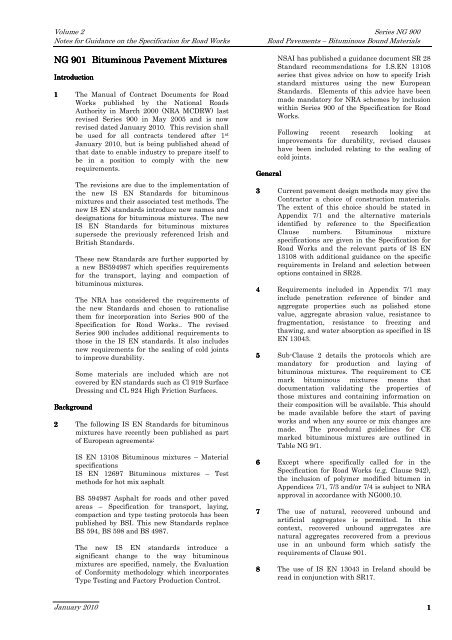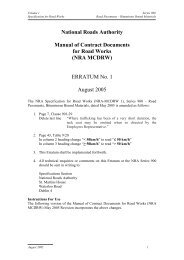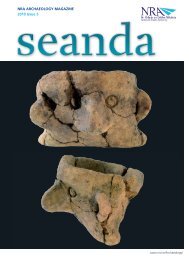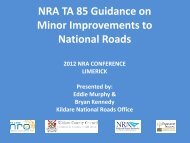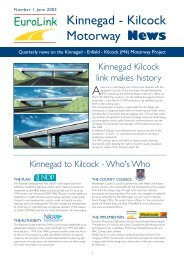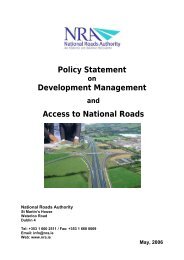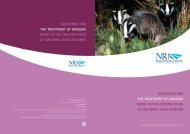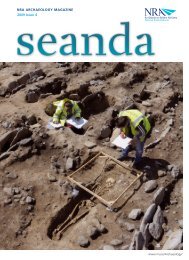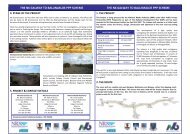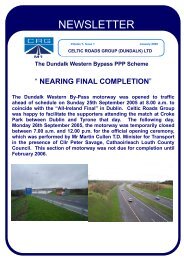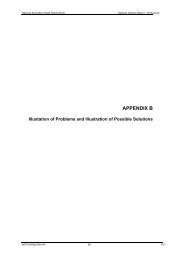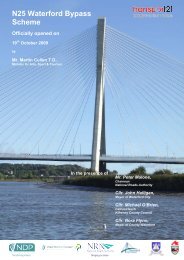ROAD PAVEMENTS – BITUMINOUS BOUND MATERIALS Contents
ROAD PAVEMENTS – BITUMINOUS BOUND MATERIALS Contents
ROAD PAVEMENTS – BITUMINOUS BOUND MATERIALS Contents
Create successful ePaper yourself
Turn your PDF publications into a flip-book with our unique Google optimized e-Paper software.
Volume 2 Series NG 900<br />
Notes for Guidance on the Specification for Road Works Road Pavements <strong>–</strong> Bituminous Bound Materials<br />
NG NG 901 901 901 Bituminous Pavement Mixtures Mixtures<br />
Introduction<br />
Introduction<br />
Introduction<br />
1 The Manual of Contract Documents for Road<br />
Works published by the National Roads<br />
Authority in March 2000 (NRA MCDRW) last<br />
revised Series 900 in May 2005 and is now<br />
revised dated January 2010. This revision shall<br />
be used for all contracts tendered after 1 st<br />
January 2010, but is being published ahead of<br />
that date to enable industry to prepare itself to<br />
be in a position to comply with the new<br />
requirements.<br />
Background<br />
Background<br />
The revisions are due to the implementation of<br />
the new IS EN Standards for bituminous<br />
mixtures and their associated test methods. The<br />
new IS EN standards introduce new names and<br />
designations for bituminous mixtures. The new<br />
IS EN Standards for bituminous mixtures<br />
supersede the previously referenced Irish and<br />
British Standards.<br />
These new Standards are further supported by<br />
a new BS594987 which specifies requirements<br />
for the transport, laying and compaction of<br />
bituminous mixtures.<br />
The NRA has considered the requirements of<br />
the new Standards and chosen to rationalise<br />
them for incorporation into Series 900 of the<br />
Specification for Road Works.. The revised<br />
Series 900 includes additional requirements to<br />
those in the IS EN standards. It also includes<br />
new requirements for the sealing of cold joints<br />
to improve durability.<br />
Some materials are included which are not<br />
covered by EN standards such as Cl 919 Surface<br />
Dressing and CL 924 High Friction Surfaces.<br />
2 The following IS EN Standards for bituminous<br />
mixtures have recently been published as part<br />
of European agreements:<br />
IS EN 13108 Bituminous mixtures <strong>–</strong> Material<br />
specifications<br />
IS EN 12697 Bituminous mixtures <strong>–</strong> Test<br />
methods for hot mix asphalt<br />
BS 594987 Asphalt for roads and other paved<br />
areas <strong>–</strong> Specification for transport, laying,<br />
compaction and type testing protocols has been<br />
published by BSI. This new Standards replace<br />
BS 594, BS 598 and BS 4987.<br />
The new IS EN standards introduce a<br />
significant change to the way bituminous<br />
mixtures are specified, namely, the Evaluation<br />
of Conformity methodology which incorporates<br />
Type Testing and Factory Production Control.<br />
General<br />
General<br />
NSAI has published a guidance document SR 28<br />
Standard recommendations for I.S.EN 13108<br />
series that gives advice on how to specify Irish<br />
standard mixtures using the new European<br />
Standards. Elements of this advice have been<br />
made mandatory for NRA schemes by inclusion<br />
within Series 900 of the Specification for Road<br />
Works.<br />
Following recent research looking at<br />
improvements for durability, revised clauses<br />
have been included relating to the sealing of<br />
cold joints.<br />
3 Current pavement design methods may give the<br />
Contractor a choice of construction materials.<br />
The extent of this choice should be stated in<br />
Appendix 7/1 and the alternative materials<br />
identified by reference to the Specification<br />
Clause numbers. Bituminous mixture<br />
specifications are given in the Specification for<br />
Road Works and the relevant parts of IS EN<br />
13108 with additional guidance on the specific<br />
requirements in Ireland and selection between<br />
options contained in SR28.<br />
4 Requirements included in Appendix 7/1 may<br />
include penetration reference of binder and<br />
aggregate properties such as polished stone<br />
value, aggregate abrasion value, resistance to<br />
fragmentation, resistance to freezing and<br />
thawing, and water absorption as specified in IS<br />
EN 13043.<br />
5 Sub-Clause 2 details the protocols which are<br />
mandatory for production and laying of<br />
bituminous mixtures. The requirement to CE<br />
mark bituminous mixtures means that<br />
documentation validating the properties of<br />
those mixtures and containing information on<br />
their composition will be available. This should<br />
be made available before the start of paving<br />
works and when any source or mix changes are<br />
made. The procedural guidelines for CE<br />
marked bituminous mixtures are outlined in<br />
Table NG 9/1.<br />
6 Except where specifically called for in the<br />
Specification for Road Works (e.g. Clause 942),<br />
the inclusion of polymer modified bitumen in<br />
Appendices 7/1, 7/3 and/or 7/4 is subject to NRA<br />
approval in accordance with NG000.10.<br />
7 The use of natural, recovered unbound and<br />
artificial aggregates is permitted. In this<br />
context, recovered unbound aggregates are<br />
natural aggregates recovered from a previous<br />
use in an unbound form which satisfy the<br />
requirements of Clause 901.<br />
8 The use of IS EN 13043 in Ireland should be<br />
read in conjunction with SR17.<br />
January 2010 1


